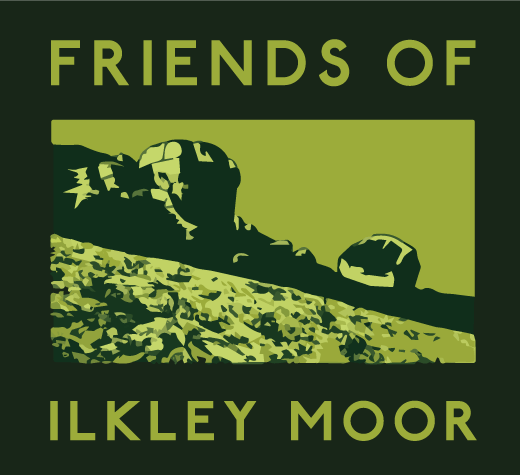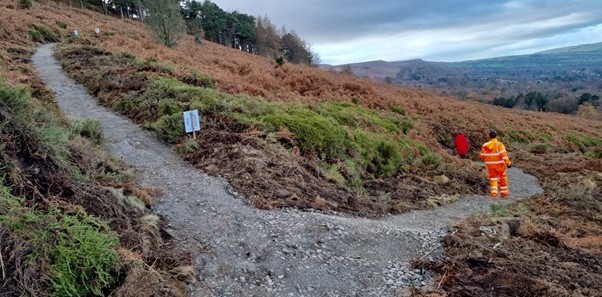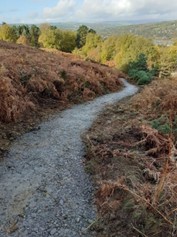The work to resurface the path from the Cow and Calf Rocks down to Cowpasture Road and to Backstone Beck has now been completed
The work to resurface the path from the Cow and Calf Rocks down to Cowpasture Road and to Backstone Beck has now been completed. We should mention that we have received complaints about this path, both from the point of view of its visual impact and the mess that was created whilst the work was ongoing.
Let’s be clear, we have never, ever resurfaced a path without receiving complaints. In the case of the path from White Wells up to the steps by the Rocky Valley it was the colour that was the chief complaint (‘a yellow scar on the Moor’). Much the same complaint was made about the path from Spicey Gill towards the Swastika Stone. There were loud complaints that we had ruined the path across the top of the Moor and, it was suggested, made it dangerous for runners, when we paved the path across the crest of the Moor. There was a complaint that we had left plastic ‘sawdust’ when we put in the boardwalk from Crawshaw Moss towards the East Buck Stones (in fact we had done our best to clear it all up, but I know of no way of cutting lengths of plastic without creating some dust). And so it goes on.
But in almost every case, as the path beds in, and the Moor regenerates, those complaints have faded away. So let’s look at why we do the work, and the constraints under which we operate.
Why we resurface paths
The overall approach to path maintenance on the upper and lower parts of the Moor is set out in the Ilkley Moor Management Plan which has been publicly available for some years. This can be accessed here: https://www.bradford.gov.uk/media/5953/ilkley-moor-management-plan.pdf
Over most of the upper Moor the soil is peat. This is easily damaged when people walk on it, and in wet weather where we have not surfaced a path, it turns into mud. Where there is a muddy area on a path, people will walk around the edge, to try and keep their boots clean and their feet dry. Thus the muddy patches become wider and wider and (especially on top of the Moor) a path could become many metres wide.
Where a path is on a slope, if unsurfaced, rain water will run down, eroding the soil and scouring the path. This also leads to increased sediment run-off which can have water quality and ecological impacts in the moorland becks and in the River Wharfe, into which they drain.
When we resurface a path firstly, we will try to put in a drainage ditch on the uphill side. This keeps water off the path and then it can be directed through pipes under the path, to undisturbed areas of the Moor where the water can soak in. In this way we reduce erosion and run off. When we put in a hard surface, then walkers (and cyclists) will stick to the path and the muddy sloughs will become revegetated and the Moor will regenerate right up to the edge of the new path. The result is a net-gain in habitat over eroded areas.
This is exactly what has happened with the paved path across the top of the Moor. Now muddy areas many metres wide have disappeared. Bits of the path that were formerly impassable in wet weather are now usable all year long. And what looked (when first installed) visually intrusive, now resembles and ancient pack horse trail.
Whenever we install a path, we think about run off and drainage and we routinely install cross drains on slopes (raised barriers to direct rain off the path onto the adjacent Moor). We normally go back, in bad weather, and invariably we find places where the cross drains need improvement, as it is never possible to tell exactly where there are springs on the Moor and where water needs diversion.
The effects of a resurfaced path can be quite dramatic in terms of nature conservation. Over the top of the Moor we now have one good East/West paved path. This means that many of the subsidiary paths are now hardly used and thus there are much larger areas of the Moor where wildlife is much less disturbed by walkers or cyclists.
On this last point it is perhaps worth pointing out that the lower slopes of the Moor, facing the town, were laid out in the Victorian period as a public park with numerous paths and artificial features (such as the Lower Tarn). We are happy to restore as many of these paths as possible. We should prefer that these lower slopes are where there is the most recreational use of the Moor. This is an area where we do not have abundant wildlife and issues of disturbance by the public are much less acute. By contrast, much of the upper plateau of the Moor is very important from the point of view of wildlife. Here if we can concentrate the traffic on a very limited number of well surfaced paths then the rest of the Moor will be comparatively undisturbed. It has been our aim that there should be two good North/South routes over the Moor (the Dick Hudson’s path and Keighley Old Road) and one good East/West Route running the whole length of Ilkley Moor from Burley Moor to Addingham High Moor. This we have very largely achieved and, if we can get Keighley Old Road closed to vehicular traffic then I think the job will be done.
Why we use particular materials
The answer to this is as brief as the first answer was long. We use the materials that are dictated by Natural England. Take the path to the Swastika Stone. How much nicer it would have looked in aesthetically pleasing grey limestone. And why did we not use limestone? It is quite simple, limestone is alkaline. It would have changed to pH of the immediate soil (which is acid) and that was not permitted by Natural England who insisted that we used sandstone. Sandstone (or gritstone) reflects the geology of the Moor, limestone is more appropriate further north in the Dales but not on Ilkley Moor.
Why do we do the work when we do
That again is simple. Natural England gives us a permit to do the work in a particular timeframe. Take the new path from the Cow and Calf rocks. Why not do the work in the summer when it is dry, why do it in autumn when it is wet? That is quite simple. We may not do any work during the ground nesting birds, nesting season.
Finally
As mentioned above, we have a good high level East/West route across the top of the Moor. Now, with the surfacing of the Cow and Calf path, we have a good, low level, properly graded and surfaced route from the Cow and Calf all the way, via the Lower Tarn, through to the Swastika Stone. I think that is an achievement to celebrate and, in a year’ time, when the path has weathered and bedded in, I am sure the complaints will have been forgotten.
And even more finally…
A Happy Christmas and a prosperous New Year to all our members.
Owen Wells
Chair, Friends of Ilkley Moor
December 2022


